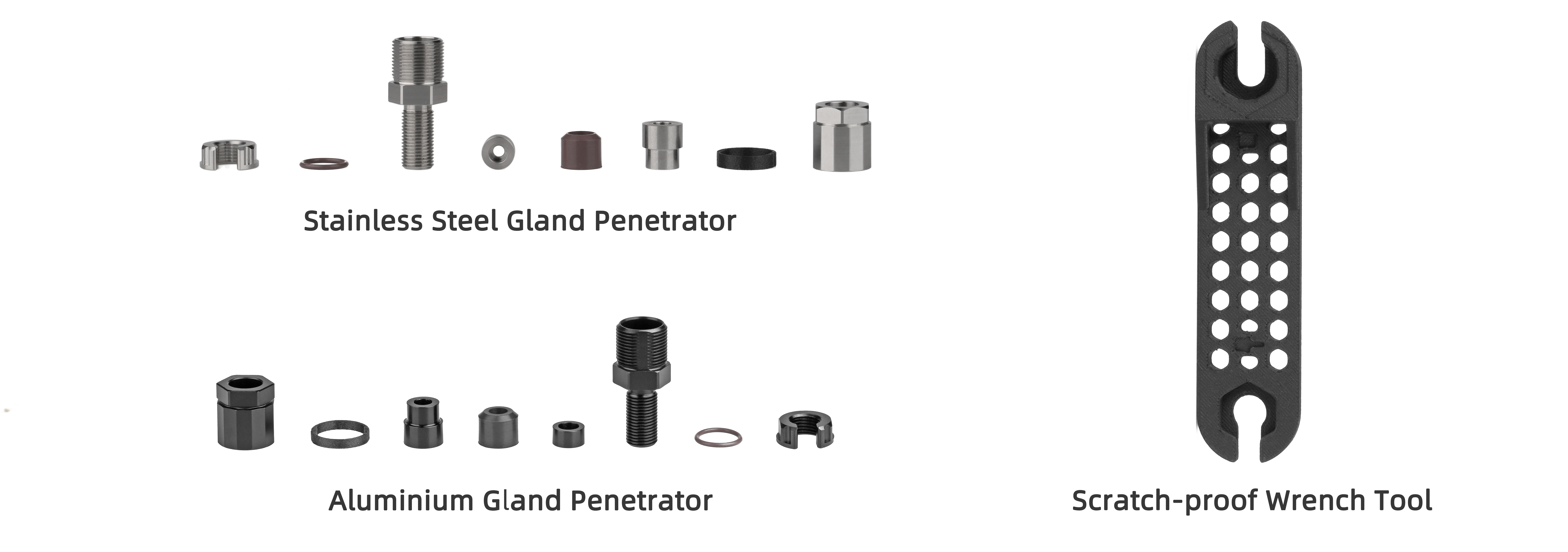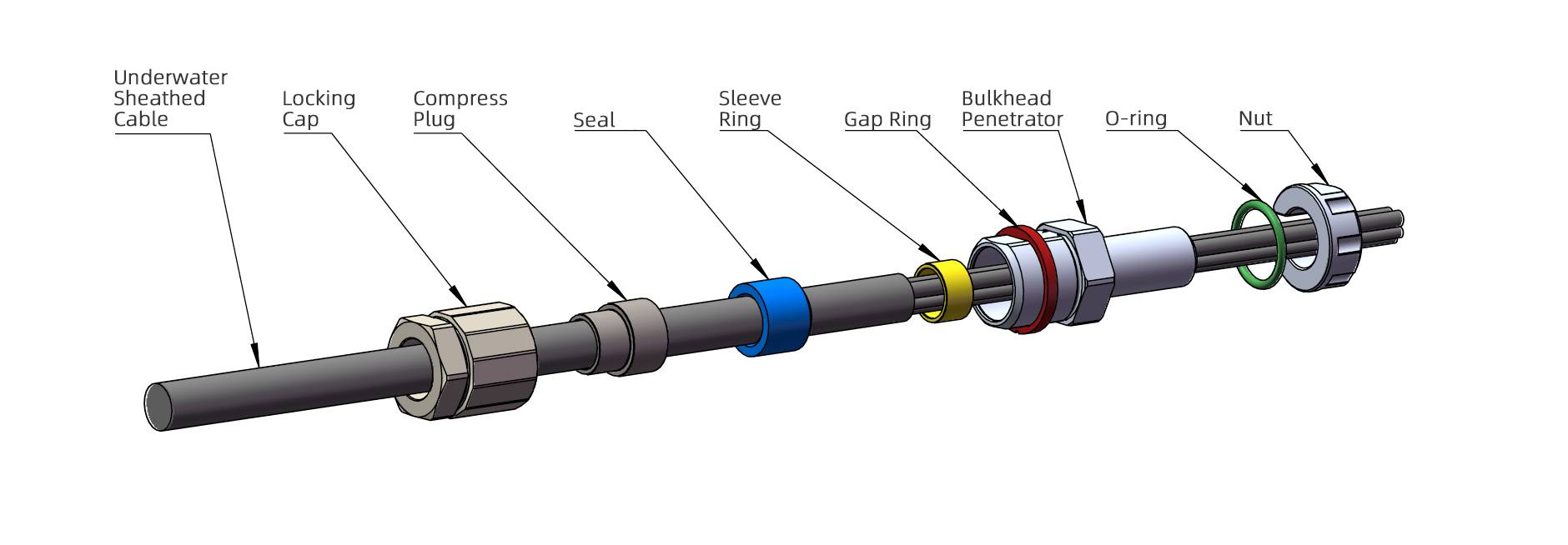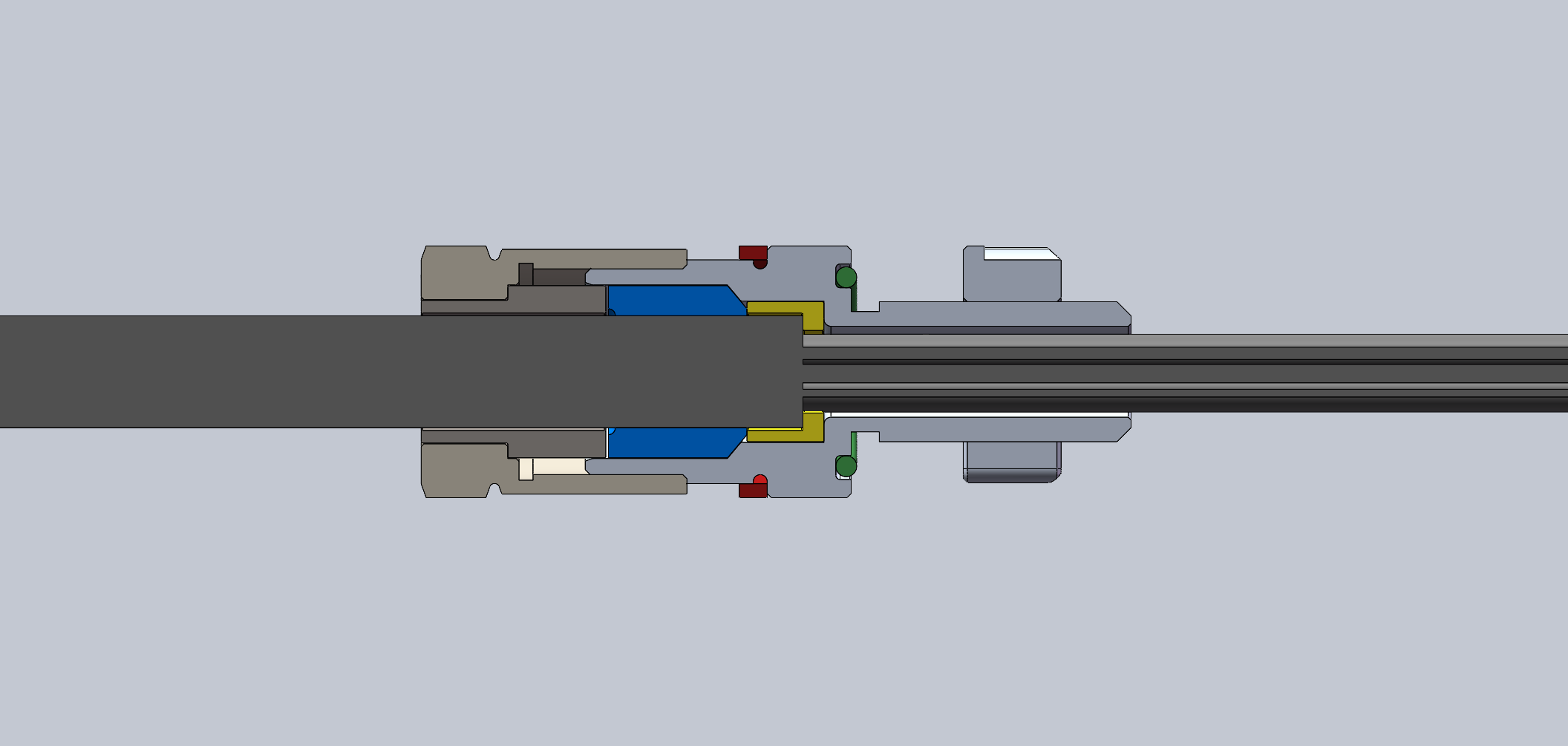Description
Gland penetrator is a common industrial component used for cable sealing. However, it is usually used for splash prevention or shallow water protection, and cannot ensure consistent pressure levels. The patented technology of the great depth water gland penetrator is relying on the accurate size of rubber and matching parts of the structural design, to realize the waterproof sheath cable without glue deep water wiring, and through the small batch long-term test, can save a lot of time to avoid the risk of bad glue filling.
It is suitable for sealing out waterproof sheathed cables up to a depth of 1000 meters (depending on the cable material) and is applicable in SUBLAB Underwater Cable or in universal sizes for other cables. The proper torque and compression for sealing can be achieved by tightening different thicknesses of gap ring.

Shipping List
- 1 x Compress Plug
- 1 x Sleeve Ring
- 1 x Seal
- 1 x Gap Ring
- 1 x Locking Cap
- 1 x O-ring
- 1 x Nut
- 1 x Bulkhead Penetrator

Specifications
| Item | SKU | Main Material | Applicable SUBLAB Cable Specifications | Sleeve Ring Specifications (A x B) | Compress Plug Specifications (A) | Gap Ring Thickness | O-ring specifications | Waterproofing Depth | Weight |
|---|---|---|---|---|---|---|---|---|---|
| 7.8 x 5.6 Stainless Steel Gland Penetrator | 13030602-0001 | 316 Stainless Steel | 3x16AWG | 7.8 x 5.6 | 7.8 | 3.0 | #3 Brown | 1000m | ≈50g |
| 7.8 x 5.6 Aluminum Gland Penetrator | 13030601-0002 | 6061 Aluminum | 3x16AWG | 7.8 x 5.6 | 7.8 | 3.0 | #3 Brown | 300m | ≈15g |
| 7.2 x 4.6 Stainless Steel Gland Penetrator | 13030602-0003 | 316 Stainless Steel | 6x24AWG | 7.2 x 4.6 | 7.2 | 2.5 | #3 Brown | 1000m | ≈50g |
| 7.2 x 4.6 Aluminum Gland Penetrator | 13030601-0004 | 6061 Aluminum | 6x24AWG | 7.2 x 4.6 | 7.2 | 2.5 | #3 Brown | 300m | ≈15g |
| 5.6 x 3.4 Stainless Steel Gland Penetrator | 13030602-0005 | 316 Stainless Steel | 4x28AWG | 5.6 x 3.4 | 5.6 | 4.0 | #2 Black | 1000m | ≈50g |
| 5.6 x 3.4 Aluminum Gland Penetrator | 13030601-0006 | 6061 Aluminum | 4x28AWG | 5.6 x 3.4 | 5.6 | 4.0 | #2 Black | 300m | ≈15g |
| 8.4 x 5.9 Stainless Steel Gland Penetrator | 13030602-0007 | 316 Stainless Steel | 2x16AWG+4x26AWG | 8.4 x 5.9 | 8.4 | 3.5 | #3 Brown | 1000m | ≈50g |
| 8.4 x 5.9 Aluminum Gland Penetrator | 13030601-0008 | 6061 Aluminum | 2x16AWG+4x26AWG | 8.4 x 5.9 | 8.4 | 3.5 | #3 Brown | 300m | ≈15g |
| 7.8 x 4.1 Stainless Steel Gland Penetrator | 13030602-0009 | 316 Stainless Steel | 2x24AWG+2x26AWG | 7.8 x 4.1 | 7.8 | 2.5 | #3 Brown | 1000m | ≈50g |
| 7.8 x 4.1 Aluminum Gland Penetrator | 13030601-0010 | 6061 Aluminum | 2x24AWG+2x26AWG | 7.8 x 4.1 | 7.8 | 2.5 | #3 Brown | 300m | ≈15g |
| 6.4 x 4.3 Stainless Steel Gland Penetrator | 13030602-0011 | 316 Stainless Steel | 3x20AWG | 6.4 x 4.3 | 6.4 | 4.5 | #2 Black | 1000m | ≈50g |
| 6.4 x 4.3 Aluminum Gland Penetrator | 13030601-0012 | 6061 Aluminum | 3x20AWG | 6.4 x 4.3 | 6.4 | 4.5 | #2 Black | 300m | ≈15g |
| Scratch-proof Wrench Tool | 13030605-0013 | FDM Printing PPA-CF | / | / | / | / | / | / | ≈42g |
Dimension:

* "S" in the figure is the thickness of the gap ring.
Part Name:


Detailed Analysis of the Seal Construction Principle:

With the locking cap tightened, the compress plug downward compression seal; seals are compressed to the inner and outer and oblique expansion; when the locking cap close to the height of the appropriate gap ring, the cable sheath is compressed to the holding position and the sheath has a clear narrowing mark, there is a certain degree of resistance to cable pulling ability.
As the external water depth or water pressure increases, the cable sheath as a whole will be compressed inward, at this time the sleeve ring is pressed against the bottom cut surface of the sheath; the seal is further compressed to hold the cable sheath; the seal is squeezed towards the internal surface of the bulkhead penetrator; the seal is pressed tighter and tighter towards the beveled surface inside the bulkhead penetrator.
The different hole diameters of the compress plugs and sleeve rings are adapted to cables with different outer diameters and sheath thicknesses, while the sleeve ring has a minimum inner diameter hole that is just the smallest diameter of the sheath's cross-section, thus holding the cable against the water pressure and preventing it from being pushed inwards by water pressure.
The split compress plug prevents the seal and other non-sealing from being twisted and displaced by friction in compression directions when the locking cap is tightened.
Split compress plugs and sleeve rings are available to accommodate different cables, or sleeve rings can be customized to integrate with the bulkhead penetrators to reduce lot cost by eliminating one part.
The thickness of the gap ring determines the screwing depth, the tightening torque of the locking cap, and the compression of the seal, so it should be selected in accordance with the recommended thickness indicated.

Recommended mounting holes:

Guides
1. Prepare the cable by cutting the sheathed cable to the appropriate length, stripping off the sheath and core filler at the end that enters the watertight enclosure, and paying attention to the flat end of the sheath.
2. Use alcohol and a dust-free cloth to clean the outer jacket of the cable and all parts of the gland penetrator.
3. Thread the parts of the gland penetrator in order, press the cable inward to tighten the shear steps against the sleeve ring, and hand-tighten the locking cap to fix it initially.
4. Use wrench and vise or special scratch-proof wrench tool to set into the locking cap and penetrator, tighten to the gap ring just do not shake.
*Note:
1. The end part of the sheath that goes into the gland penetrator needs to be cut flat and fit the sleeve ring.
2. All parts must be wiped clean with alcohol, especially the cables, penetrator inside, seals, any dust oil stains and other impurities will have an effect on the seal.
3.
Aluminum version of the gland penetrator is not suitable for conventional wrenches and bench vise, it will pinch and clip deformation, affecting the seal and appearance. We recommend using a special scratch-proof wrench tool.
4. Special scratch-proof wrench tools may be loosened after repeated use, is a normal phenomenon, pay attention to tighten to the gap ring does not shake and then do not continue to tighten the wrench caused by excessive loosening, the normal application of force to tighten in place will not damage the tool.
5. You can go to makerworld to download the print file of the scratch-proof wrench tool and print it by yourself, we recommend PPA-CF or other engineering materials with the same strength, ordinary materials can not be used.
6.
You can download the gap ring print files from makerworld and print it yourself. Use multi-colored gap rings to distinguish between cables, it can be printed with ordinary water-resistant materials.
7. There might be errors in the thickness of the matching gap rings, but they are within the appropriate range of validation.
8. The wrenches printed by downloading the model may have size errors and need to be adjusted by yourself, or you can buy the finished wrenches in SUBLAB.
9. In the process of tightening the locking cap, the cable should be tightened inward to make the cable shearing surface stand against the sleeve ring.

How to choose the specifications of gland penetrator for third-party cables?
As the principle of detailed analysis, the decision to select the specifications of the gland penetrator of two data: 1. cable sheath of the outer diameter a, 2. cable sheath of the inner diameter of b (expressed as the smallest hole through which the inner core of the entire cable can pass);
Suitable for matching the sleeve ring specifications A x B that is the comparison of these two data, which need to meet the A ≥ a; B ≥ b, and , (A-a) ≤ 0.8; (B-b) ≤ 0.8, within this range, can be used along the labeled gap ring specifications.
The above is the conclusion of a large number of product test data, but the use of third-party cables still need to carry out specialized water pressure testing, including high and low temperatures, pressure shock and a long period of pressure preservation (recommended pressure preservation for 2 weeks).
If a and b any one of the data is not in the range, it is necessary to test the thickness of the other gap rings, that is, the amount of compression, compression of the simple test method is, after installation, pulling the cable, test the cable from the gland penetrator out of the release force.
Among them, you also need to consider the cable sheath material and hardness data, both of which greatly affect the sealing performance.
In short, when using third-party cables, be sure to perform several seal reliability tests.
Special specifications of the cable and data does not match the cable, should be proposed size customization and specification expansion, and not hastily selected.
FAQ
● Can the sealing part be disassembled and assembled repeatedly?
It is not recommended to dismantle the sealing part repeatedly, if you have to dismantle the sealing part, try not to do it more than 2 times, and the cable which has been compressed should not be compressed again in the same position, and the cable sheath should be cut again.
● How is the waterproof depth guaranteed?
The dimensional structure of this patented design is such that when the locking cap is screwed to the specified position, the compression of the seal meets the sealing requirements for the indicated water depth.
● What are the advantages over glue-filled cable penetrator/ underwater connectors?
The tails of glued cable penetrators cannot be bent or pulled; there is no need to wait for the glue to cure, the seal is completed by tightening in place; and it can be disassembled, whereas glued cable penetrators require the cable to be cut and the penetrators discarded.
The main advantage is no potting, more reliable and convenient than cable penetrators, eliminating the need to wait for the glue to cure. It is a non-pluggable fixed outlet connection than underwater connectors.
● Are there other forms of mounting?
The standard product is a bulkhead penetrator and a nut with a O-ring, It is installed in a similar way to the cable penetrators.
Other mounting methods will be available later, such as a gland penetrator with a step edge that is screwed to a end cap, or a method that directly inserts a smooth cylindrical surface with a O-ring into a hole.
● Is the water depth data a theoretical value?
The water depth data is the theoretical value? It is the data of actual small batch pressure test, such as 1000 meters water depth, the actual pressure test according to 1200 meters for more than a week.
● Can other brands of cables be used?
Pressure testing is required to determine suitability, and the rated water depth is the result of testing with SUBLAB standard cables.
